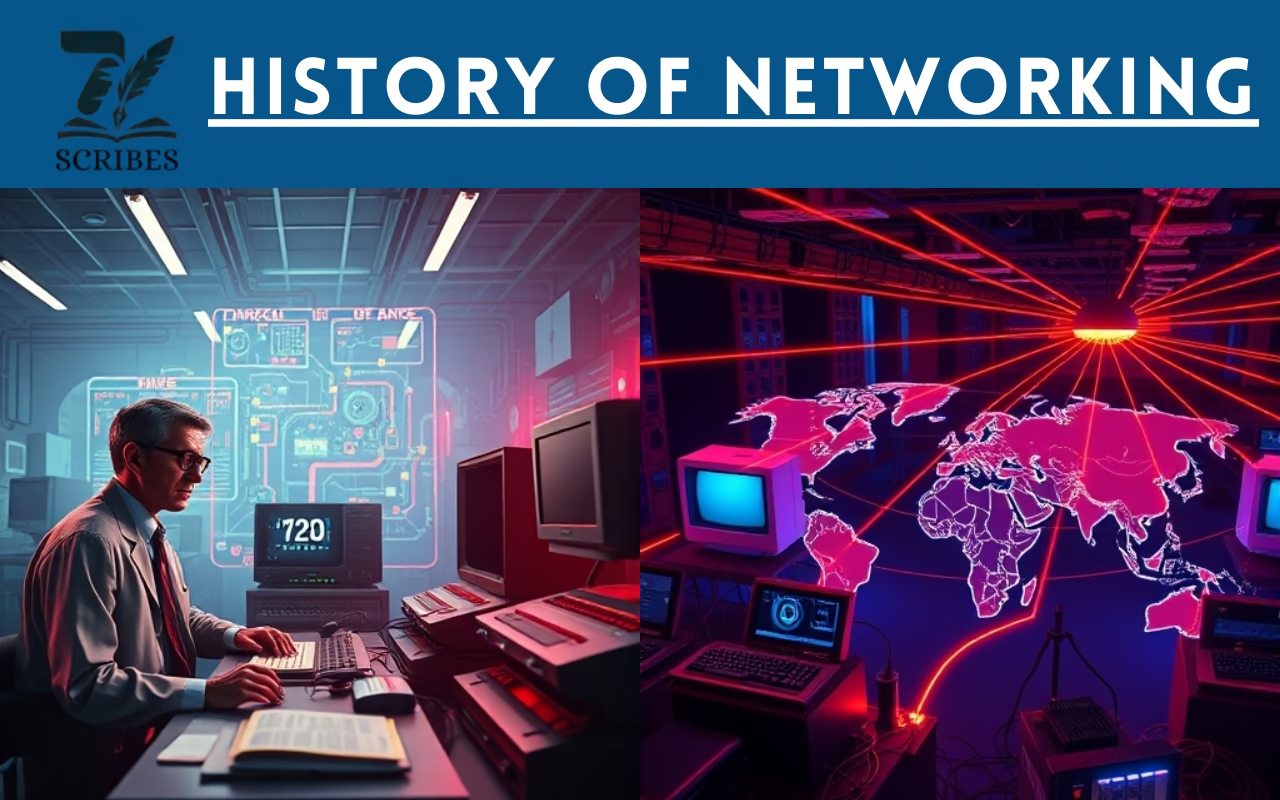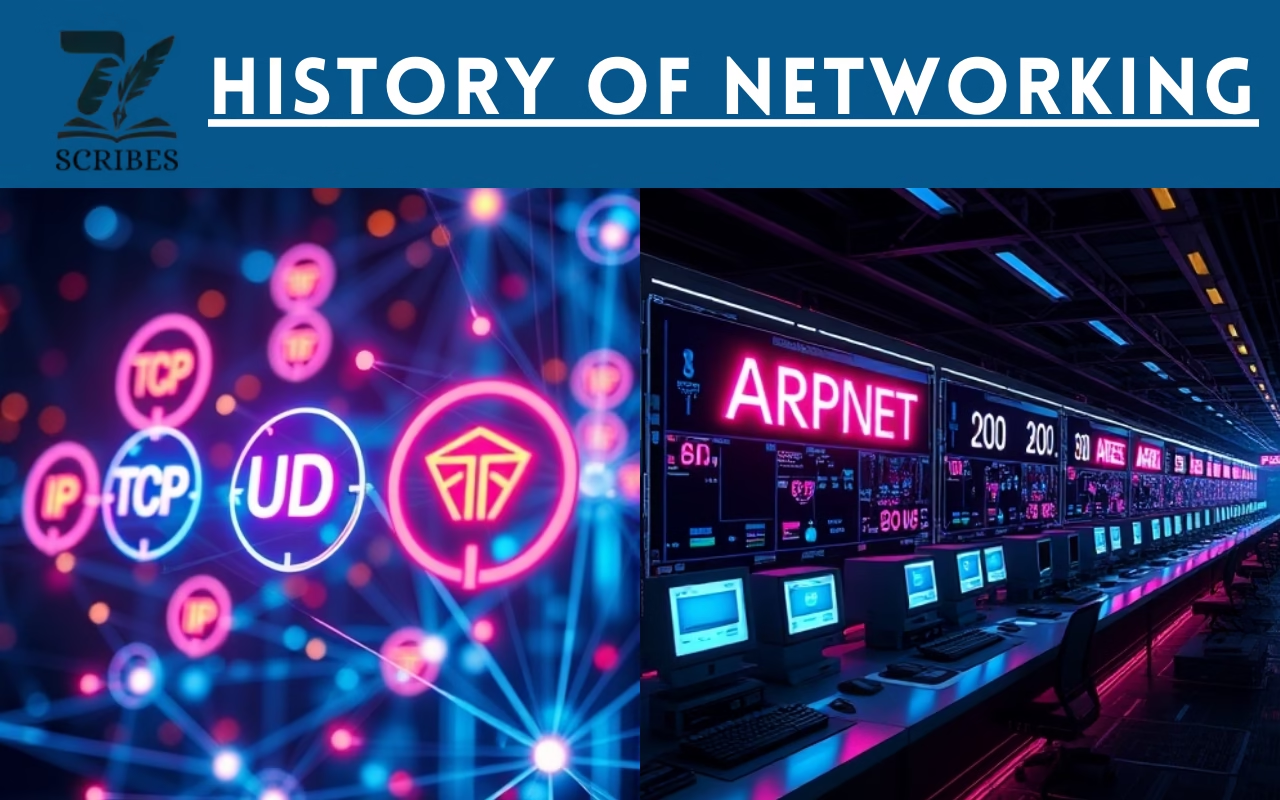Networking
A network is a collection of computers connected to share information, resources, and data. The network allows data to be stored on separate devices on the network and the servers. We can say that networking is the lifeline for the internet because the internet arises from networking (as we know the internet is the interconnection of a large number of computers). Without the networking of computers and systems, no one can access data, information, and resources from the internet.

Characteristics of Networking:
Functional Characteristics
- Resource Sharing: Networks allow devices to share resources, such as files, printers, and internet connections.
- Communication: Networks enable devices to communicate with each other, exchanging data and information.
- Security: Networks provide mechanisms for securing data and controlling access to resources.
Performance Characteristics
- Bandwidth: The amount of data that can be transmitted over a network in a given time.
- Latency: The time taken by data to travel from one node to another.
- Reliability: The capability of a network to maintain connections and deliver data without distrup.
History of Networking:
In this article, we discussed the history of networking from packet switching to the explosion of the internet.
Revolutionizing Communication: The Rise of Packet Switching (1961-1972)
The begining of computer networking and internet begans in 1960s. Telephone networking uses circuit switching for the transmission of data. Three groups from all over the world working on networking without knowing each other work began to develop packet switching as a more efficient and robust alternative to circuit switching. Leonard Kleinrock (1961; 1964) was a graduate student at MIT. He published work on packet-switching techniques. By using queuing theory he demonstrated the effectiveness of packet switching for bursty traffic. In 1964, Paul Baran investigated how much circuit switching is secure for voice-over military networks at the National Physical Laboratory in England. Other investigators (also referred to as scientists or researchers) like Donald Davies and Roger Scantlebury developing opinions about packet switching. The early beginning of the internet was four nodes large by the end of 1969. The first network to perform a remote login from UCLA to SLR but unfortunately, crashed the system.

By the end of 1972, ARPANET grew up to 15 nodes network and it was demonstrated by Robert Kahn. The first host-to-host York protocol used between Arpanet nodes is the network control protocol (NCP) completed. The first email Ws was written by Ray Tomlinson in 1972.
Proprietary Networks: The Building Blocks of Modern Internet working (1972-1980)
The first Arpanet was a single closed network. Whenever needed to communicate with an Arpanet host, one had attached to another Arpanet IMP. ALOHANet, an additional standalone packet switching network developed in the early mid-1970s, is a microwave network linking universities on the Hawaiian Islands. A packet-based radio network that allowed multiple remote sites on the Hawaiian Islands to communicate with each other. The ALOHA protocol was the first multiple-access protocol, allowing geographically distributed users to share a single broadcast communication medium. They also developed the Ethernet protocol for wired-based shared networks. It lays the foundation for today’s PC’s LAN. Other networks are DARPA’s, Telnet, Cyclades, Tymnet, and GE Information Services network, and IBM’s SNA was developed in the year 1977.

The main three internet protocols that are used today are TCP, UDP, and IP were conceptually based at the end of the 1970s.
Networking Boom: The Surge of Connectivity (1980-1990)
By the end of the 1970s, approximately 200 hosts were connected to ARPAnet, setting the stage for the public Internet. This number skyrocketed to 100,000 hosts by the end of the 1980s, a decade characterized by remarkable expansion fueled by various initiatives aimed at connecting universities.
Major Networking Initiatives
BITNET enabled email and file sharing among universities in the Northeast, while CSNET was established to connect researchers lacking access to ARPAnet. In 1986, NSFNET was launched to link NSF-sponsored supercomputing centers, initially operating at 56 kbps and upgrading to 1.5 Mbps by the decade’s conclusion.

A significant milestone occurred on January 1, 1983, when TCP/IP was adopted as the standard protocol for ARPAnet, replacing the older NCP protocol. This transition mandated that all hosts switch to TCP/IP on that date. Additionally, enhancements to TCP for congestion control were introduced in the late 1980s, and the Domain Name System (DNS) was created to convert human-readable names into IP addresses.
International Developments
In parallel, France initiated the Minitel project in the early 1980s, aiming to bring data networking into homes. This government-backed initiative featured a public packet-switched network and affordable terminals. The Minitel gained significant traction in 1984 when free terminals were distributed to French households, offering both complimentary and fee-based services.
Internet (1990s)
The 1990s heralded a pivotal shift in the evolution and commercialization of the Internet. With the decommissioning of ARPAnet, the groundwork was laid for a new era. In 1991, NSFNET removed its restrictions on commercial use, and by 1995, it was fully decommissioned, transitioning Internet backbone traffic to commercial Internet Service Providers.
Rise of the World Wide Web
The most significant development of the decade was the advent of the World Wide Web, which made the Internet accessible to millions of homes and businesses. The Web became a platform for numerous applications that are now integral to our daily lives, including search engines (like Google and Bing), online shopping (such as Amazon and eBay), and social networking (like Facebook).
Tim Berners-Lee invented the Web at CERN between 1989 and 1991, drawing inspiration from earlier hypertext concepts by Vannevar Bush and Ted Nelson. His team created essential technologies, including HTML, HTTP, a web server, and a browser. By late 1993, around 200 Web servers were operational, foreshadowing the explosive growth to come. During this period, several researchers developed graphical web browsers, notably Mosaic, founded by Marc Andreessen and Jim Clark, which later became Netscape Communications Corporation. By 1995, Netscape was widely used by university students, prompting businesses to establish web servers and engage in online commerce. In 1996, Microsoft entered the browser market, sparking a competitive “browser war” with Netscape.
Growth and Innovation
The latter half of the 1990s was marked by rapid growth and innovation, with major corporations and startups launching a variety of Internet products and services. By the end of the decade, the Internet supported numerous popular applications, particularly four key ones:
- Email, including attachments and web-accessible options
- The Web, encompassing browsing and online shopping
- Instant messaging with contact lists
- Peer-to-peer file sharing of MP3s, notably initiated by Napster
Interestingly, the first two applications originated from the research community, while the latter two were developed by young entrepreneurs.
Financial Volatility
From 1995 to 2001, the Internet’s presence in financial markets was tumultuous. Numerous startups went public, often valued in the billions despite lacking significant revenue. The dot-com bubble burst in 2000-2001, leading to the collapse of many companies. However, several firms emerged as major players in the Internet landscape, including Microsoft, Cisco, Yahoo, eBay, Google, and Amazon.
Networking in the 21st Century
Since the start of the new millennium, computer networking has seen rapid advancements, particularly in several key areas:
Broadband Internet Access: There has been a significant increase in broadband options, including cable modems, DSL, and fiber-to-the-home. This high-speed Internet access has enabled a variety of video applications, such as user-generated content on YouTube, on-demand streaming services like Netflix, and multi-person video conferencing through platforms like Skype.
High-Speed Wireless Connectivity: The proliferation of high-speed public WiFi (54 Mbps and above) and medium-speed access via 3G and 4G cellular networks has allowed users to stay connected while on the go. By 2011, wireless devices outnumbered wired ones, leading to the rise of handheld devices like iPhones and Androids that provide constant Internet access.
Online Social Networks: Platforms such as Facebook and Twitter have created extensive social networks, with many users primarily engaging through these sites. Their APIs have facilitated the development of new applications and distributed games.
Private Networks by Major Providers: Companies like Google and Microsoft have established extensive private networks to connect their global data centers, allowing them to bypass the public Internet and deliver services like search and email almost instantaneously.
Cloud Computing: Many businesses now run their applications in the cloud, utilizing services such as Amazon EC2, Google’s Application Engine, and Microsoft Azure. This transition allows companies and universities to host applications like email and web services in the cloud, benefiting from scalable resources and access to high-performance private networks. These developments have fundamentally transformed how we connect, communicate, and conduct business in the digital age.
Summary
Networking refers to the interconnection of computers to share information, resources, and data, forming the backbone of the Internet. The history of networking can be traced from the development of packet switching in the early 1960s to the explosive growth of the Internet in the 1990s and beyond. In the early 1960s, researchers began exploring packet switching as a more efficient alternative to circuit switching used in telephone networks. Key figures like Leonard Kleinrock, Paul Baran, Donald Davies, and Roger Scantlebury contributed to this development. By the end of 1969, ARPANET was established with four nodes, and by 1972, it had expanded to 15 nodes, introducing the first email by Ray Tomlinson. ARPANET initially functioned as a closed network. During the 1970s, additional networks like ALOHANET and Ethernet emerged, laying the groundwork for modern networking. By the late 1970s, foundational Internet protocols such as TCP, UDP, and IP were conceptualized. The number of hosts on ARPANET grew from about 200 in the late 1970s to 100,000 by the end of the 1980s, driven by initiatives like BITNET and NSFNET. The adoption of TCP/IP as the standard protocol in 1983 and the creation of the Domain Name System (DNS) were significant milestones. The 1990s marked a major shift with the decommissioning of ARPANET and the commercialization of the Internet. The introduction of the World Wide Web by Tim Berners-Lee made the Internet accessible to millions, leading to the rise of search engines, online shopping, and social networking. The decade also saw the emergence of major applications like email, instant messaging, and peer-to-peer file sharing. Since 2000, networking has advanced rapidly with the widespread deployment of broadband Internet, high-speed wireless connectivity, and the rise of online social networks. Major companies have built private networks to enhance service delivery, and cloud computing has transformed how businesses operate, allowing scalable access to applications and resources.
FAQs about Networking
1. What is networking?
Networking is the practice of connecting computers and devices to share information, resources, and data. It forms the foundation of the Internet, allowing users to access and exchange information seamlessly.
2. What are the main characteristics of networking?
The main characteristics of networking include:
Connectivity: Ability to connect a large number of devices.
Resource Sharing: Facilitates sharing and accessing resources among connected devices.
3. What is packet switching?
Packet switching is a method of data transmission where data is broken into smaller packets that are sent independently over the network and reassembled at the destination. This approach is more efficient and robust compared to traditional circuit switching.
4. How did networking develop between 1961 and 1972?
The Development of packet switching began in the early 1960s, with significant contributions from researchers like Leonard Kleinrock and Paul Baran. This period saw the establishment of ARPANET, the first network to implement packet switching, leading to the creation of the Internet.
5. What were proprietary networks?
Proprietary networks were closed systems developed by companies to connect their own devices and resources. These networks laid the groundwork for the concept of internetworking, allowing different networks to communicate with one another.
6. What major achievements occurred in networking during the 1980s?
The 1980s witnessed the proliferation of networks, including the establishment of BITNET and NSFNET, which connected universities. The adoption of TCP/IP as the standard protocol in 1983 was a crucial milestone for the Internet.
7. How did the World Wide Web impact networking in the 1990s?
The World Wide Web, invented by Tim Berners-Lee, made the Internet accessible to the general public. It led to the rapid growth of online applications, including search engines, e-commerce, and social networking, transforming how people interacted with the Internet.
8. What advancements have been made in networking since the year 2000?
Since 2000, networking has advanced significantly with the rise of broadband Internet, high-speed wireless connectivity, cloud computing, and the development of extensive private networks by major tech companies.
9. What role does cloud computing play in modern networking?
Cloud computing allows businesses and organizations to host applications and services online, providing scalable resources and access to high-performance networks without the need for extensive on-premises infrastructure.
10.What are the benefits of networking?
Networking offers numerous benefits, including improved communication, resource sharing, enhanced collaboration, increased efficiency, and access to a vast array of information and services across the globe.
Read More :
Step-by-Step Guide to the 2025-2026 Fulbright Scholarship Application
4. Computer network(Wikipedia)